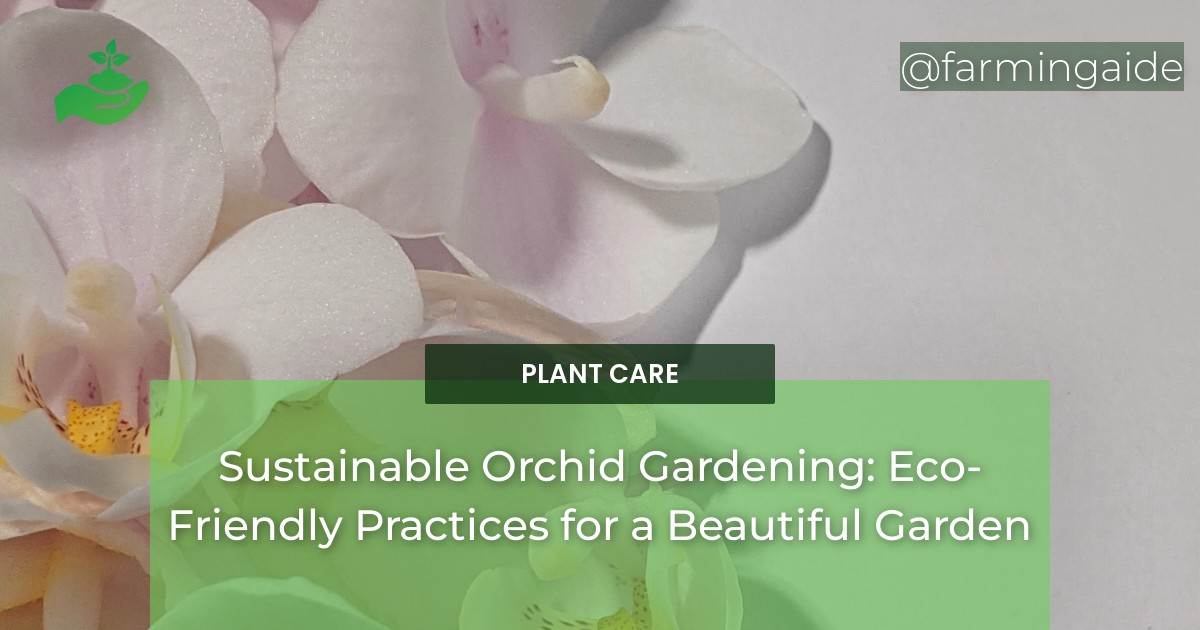Sustainable gardening is becoming increasingly popular as people become more aware of the impact of traditional gardening practices on the environment. By using eco-friendly methods, we can create beautiful gardens while also preserving the planet for future generations. In this article, we will explore the world of sustainable orchid gardening, a specific type of gardening that focuses on using environmentally-friendly practices to grow and care for orchids. From plant selection and cultivation to pest control and seasonal planning, we will cover all the essential aspects of sustainable orchid gardening and provide tips for creating a thriving and sustainable orchid garden. So, let’s dive in and discover the beauty and benefits of sustainable orchid gardening.
Plant Selection and Cultivation
When it comes to sustainable gardening, plant selection is crucial. Choosing the right plants for your garden can help reduce the need for excessive watering, fertilizing, and pest control. When it comes to orchids, it is essential to select native and non-invasive species to ensure they thrive in their natural environment. Some popular native orchid species include Cattleya, Dendrobium, and Phalaenopsis.
Each type of orchid has specific cultivation needs, so it is essential to research and understand the requirements of the species you want to grow. For example, some orchids prefer bright, indirect light, while others thrive in low light conditions. Additionally, understanding the ideal temperature, humidity, and watering needs of your orchids is crucial for their successful cultivation.
Propagation and transplanting are also essential aspects of orchid cultivation. Propagation is the process of creating new plants from existing ones, and it is a great way to expand your orchid collection. Transplanting, on the other hand, involves moving an orchid from one pot to another or from a pot to the ground. It is essential to follow proper techniques and use the right tools to ensure successful propagation and transplanting.
Soil Management and Composting
Healthy soil is the foundation of any successful garden, and sustainable orchid gardening is no exception. Orchids require well-draining soil that is rich in nutrients. Some types of orchids, such as epiphytes, do not require soil at all and can be grown on a variety of surfaces, such as bark or rocks.
Composting is an essential practice in sustainable gardening as it helps reduce waste and enrich the soil with essential nutrients. Compost is made from organic materials such as food scraps, yard waste, and manure. It can be added to the soil to improve its structure, water retention, and nutrient content. Composting also helps reduce the need for chemical fertilizers, making it an eco-friendly option for sustainable orchid gardening.
Pest and Disease Control
One of the biggest challenges in gardening is dealing with pests and diseases. In sustainable orchid gardening, it is essential to use eco-friendly methods for preventing and managing these issues. Some natural pest control methods include using companion planting, which involves growing plants that attract beneficial insects that can help control pests.
It is also crucial to regularly inspect your orchids for any signs of pests or diseases and take immediate action to prevent them from spreading. Some common pests that affect orchids include aphids, mealybugs, and spider mites, while common diseases include root rot and fungal infections. By using natural methods and being proactive in pest and disease control, you can maintain a healthy and sustainable orchid garden.
Sustainable Gardening Practices
In addition to using eco-friendly methods for plant selection, cultivation, and pest control, there are other sustainable gardening practices that can be applied to orchid gardening. These include conserving water by using drip irrigation systems and rain barrels, reducing energy use by using solar-powered lights and tools, and avoiding harmful chemicals by using organic fertilizers and pesticides.
Creating a self-sustaining ecosystem in your orchid garden is also an essential aspect of sustainable gardening. This involves incorporating plants that attract pollinators, such as bees and butterflies, and using natural methods to maintain a healthy balance of pests and beneficial insects. By creating a self-sustaining ecosystem, you can reduce the need for external inputs, making your orchid garden more sustainable in the long run.
Seasonal Planning and Crop Rotation
Planning and rotating crops is another crucial aspect of sustainable gardening. By rotating crops, you can prevent soil depletion and maintain a healthy balance of nutrients in the soil. This is especially important for orchids, as they require specific nutrients to thrive. Additionally, understanding the light and temperature needs of your orchids can help you choose the best location for them in your garden.
Extreme weather conditions can also affect orchids, so it is essential to take precautions to protect them. This can include moving them indoors during extreme heat or cold, providing shade during hot summer days, and using mulch to protect the roots during winter.
How Can Eco-Friendly Practices Be Incorporated into Year-Round Orchid Gardening?
When delving into yearround orchid garden planning, eco-friendly practices can be seamlessly integrated. Start by opting for organic fertilizers and pest control methods. Repurpose rainwater for irrigation and consider installing a solar-powered watering system. Embrace companion planting by placing complimentary plants near orchids to enhance pollination and deter pests naturally. Incorporate sustainable materials like bamboo stakes and eco-friendly pots. Nurture a thriving orchid garden while prioritizing the environment.
Conclusion
Sustainable orchid gardening is not only beneficial for the environment, but it also allows us to create beautiful and thriving gardens. By selecting native and non-invasive orchid species, using eco-friendly methods for soil management and pest control, and adopting sustainable gardening practices, we can create a self-sustaining ecosystem in our orchid gardens. So, let’s do our part in preserving the planet and create stunning orchid gardens that are both beautiful and sustainable.


